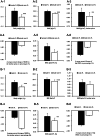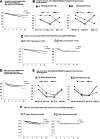Optimal body mass index for protecting middle-aged and elderly patients with fatty liver from future fractures
- PMID: 38819306
- PMCID: PMC11227054
- DOI: 10.1530/EC-24-0089
Optimal body mass index for protecting middle-aged and elderly patients with fatty liver from future fractures
Abstract
Objective: Previous studies have suggested that body mass index (BMI) should be considered when assessing the relationship between fatty liver (FL) and osteoporosis. The aim of this study was to investigate future fracture events in people with FL, focusing on the effect of BMI in both sexes.
Methods: This retrospective cohort study, spanning from 2011 to 2019, enrolled 941 people, including 441 women and 500 men, aged 50 years or older who underwent liver imaging (ultrasound, computed tomography, or magnetic resonance image) and dual-energy X-ray absorptiometry (for bone mineral density measurements). The study examined predictors of osteoporosis in both sexes and the effect of different ranges of BMI (18.5-24, 24-27, and ≥27 kg/m2) on the risk of future fracture events in FL patients.
Results: The average follow-up period was 5.3 years for women and 4.2 years for men. Multivariate analysis identified age and BMI as independent risk factors of osteoporosis in both sexes. Each unit increase in BMI decreased the risk of osteoporosis by ≥10%. In both women and men with FL, a BMI of 24-27 kg/m2 offered protection against future fractures, compared to those without FL and with a BMI of 18.5-24 kg/m2.
Conclusion: The protective effect of a higher BMI against future fractures in middle-aged and elderly female and male patients with FL is not uniform and diminishes beyond certain BMI ranges.
Keywords: body mass index; bone mineral density; fatty liver; fracture; osteoporosis.
Conflict of interest statement
The authors declare that there is no conflict of interest that could be perceived as prejudicing the impartiality of the study reported.
Figures



Similar articles
-
Utilization of DXA Bone Mineral Densitometry in Ontario: An Evidence-Based Analysis.Ont Health Technol Assess Ser. 2006;6(20):1-180. Epub 2006 Nov 1. Ont Health Technol Assess Ser. 2006. PMID: 23074491 Free PMC article.
-
BMI and gender increase risk of sacral fractures after multilevel instrumented spinal fusion compared with bone mineral density and pelvic parameters.Spine J. 2019 Feb;19(2):238-245. doi: 10.1016/j.spinee.2018.05.021. Epub 2018 May 21. Spine J. 2019. PMID: 29792998
-
A high body mass index protects against femoral neck osteoporosis in healthy elderly subjects.Nutrition. 2004 Sep;20(9):769-71. doi: 10.1016/j.nut.2004.05.014. Nutrition. 2004. PMID: 15325685
-
Osteoporosis – Prevention, Diagnosis and Treatment: A Systematic Review [Internet].Stockholm: Swedish Council on Health Technology Assessment (SBU); 2003 Oct 14. SBU Yellow Report No. 165/1+2. Stockholm: Swedish Council on Health Technology Assessment (SBU); 2003 Oct 14. SBU Yellow Report No. 165/1+2. PMID: 28876760 Free Books & Documents. Review.
-
Bone density measurement--a systematic review. A report from SBU, the Swedish Council on Technology Assessment in Health Care.J Intern Med Suppl. 1997;739:1-60. J Intern Med Suppl. 1997. PMID: 9104441
References
LinkOut - more resources
Full Text Sources

